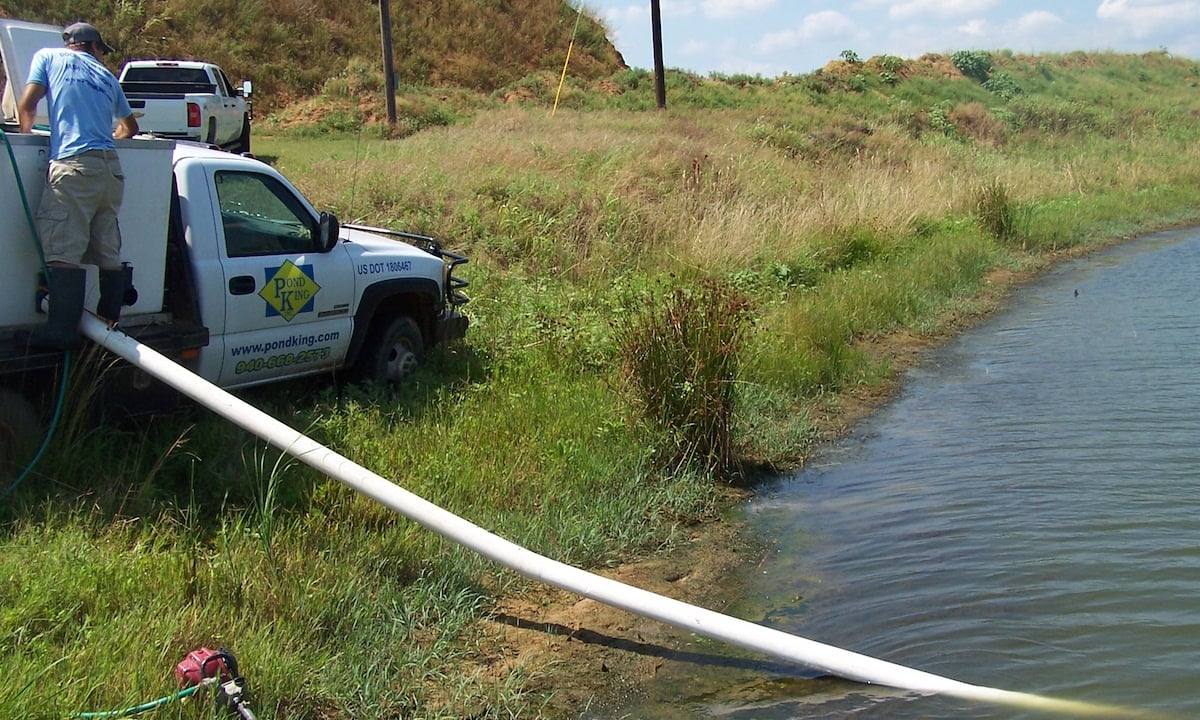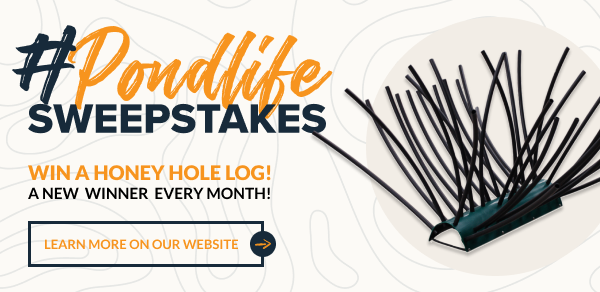There are many different factors that go into the process of stocking your pond. Consulting with professionals like a Pond King fisheries biologist is the best place to start.
At Pond King, our team can determine which species are best suited for your pond, as well as the rate of stocking.
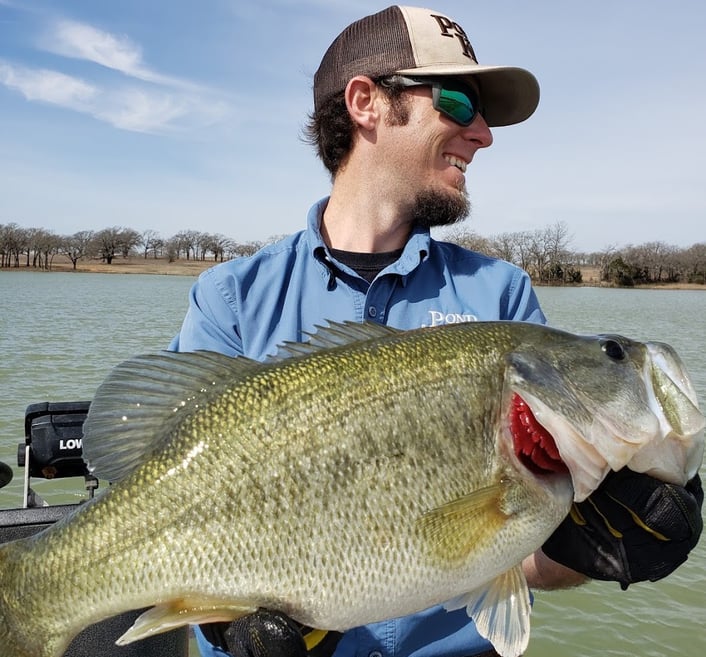
Building the Fishery of Your Dreams!
When you first lay eyes on your newly purchased or constructed pond, everyone begins to have grand dreams of what it could become. These visions of the drag screaming, maxed out fishing scales, or full stringers are most often accompanied by the enjoyment and laughter of family and friends that you share these moments with down at the pond.
Making Your Dreams a Reality!
While these visions are easy to dream up, making them manifest into reality is sometimes not quite as easy. It may seem as simple as purchasing a few fish and releasing them into your fishery. However, there are many other aspects to consider when it comes to determining the correct sizes, quantities, and species you introduce to maximize the potential of your pond or lake in a timely manner.
What are Your Pond or Lake Management Goals?
The first step in this process is establishing the main goals for your pond.
For example, are you trying to produce trophy Bass or have a place where you can take the kids or grandkids and keep everyone engaged catching fish? Or, are you wanting to diversify your fishing opportunities and have a miniature lake in the back 40?
For help with goal setting, visit our post about determining the type of fishery your pond or lake can support.
Factors to Consider When Preparing Your Pond’s Future
While your goals for the fishery help to provide a direction for the pond’s future, there are a few other aspects that will determine the success of the fish stocking plan.
Consulting with a Biologist is the first step in stocking any new or existing fishery. In some cases, the fishery's current composition is adequate to meet your goals, and other times it's not.
The simplest option is to work with what you have.
Now, that doesn't mean that the pond or lake's current situation is its final outcome. Fisheries Biologists can give you recommendations for stocking your existing pond or lake, as well as other potential management options to improve the possibilities of your fishery.
Consider Your Pond’s Existing Composition and Habitat
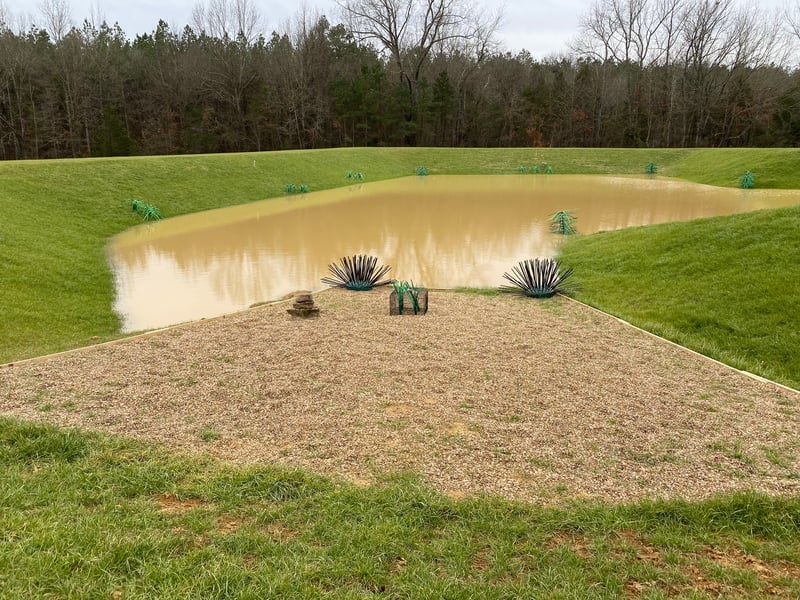
Pond composition and habitat availability are some of the first aspects considered when putting together a stocking plan, including:
- size
- depth profile
- flow-through
- water retention of the pond
- habitat availability
The compilation of responses from these varying factors helps determine the viability of a species' success in both growth and reproduction for the fishery. It will also help determine if additional species should be introduced to help manage other environmental factors such as aquatic vegetation or unwanted species that could be introduced naturally.
The Size of a Pond is a Major Factor on Stocking Capability
Consider an example of a pond that is less than one acre, loses water volume significantly during the summer months, and has a large portion of the pond that is very shallow.
This collection of factors makes this pond unsuitable for Bass production.
Why Would Stocking Bass Be Problematic for Small Ponds?
Here is why: this small pond will easily become overpopulated with Largemouth Bass because of their high reproductive success. In addition to the large portion of shallow areas, the loss of water volume during the summer will decrease the total available area for both your Bass and Forage species.
Furthermore, this confinement concentrates the Biomass of the pond to a smaller area, increasing the risk of oxygen depletion, which could cause a fish kill.
Therefore, investing time and money in stocking Bass and forage densities to support adequate Bass growth in a pond like this would potentially be a total loss, with a slim potential for producing even quality size Bass.
Larger Ponds and Lakes are Viable Habit for a Variety of Fish Species
However, larger ponds or lakes that can sustain adequate water levels during periods of little rainfall will support a larger population of predatory species, like Bass. The amount of structural habitat is another factor that helps increase the quality of Bass. Luckily this is an easy factor to manipulate if the pond's current condition is lacking.
Communicating with a Biologist would help you determine what you could easily remedy and what will require a workaround.
Water Clarity
While water clarity seems like more of a parameter for choosing which bait to fish instead of which species to stock, it is still an essential factor to keep in mind.
Certain species such as Catfish, Hybrid Bluegill, and Hybrid Stripers do better in small, persistently muddy ponds, whereas Bass do better in ponds and lakes that have a healthy phytoplankton bloom to limit the visibility.
Regardless of which species you introduce, a key management practice is limiting the clarity of the water. While clear water paints a picturesque scene, it has significantly less productivity potential compared to even a highly turbid pond and makes it harder for your predators to capture prey.
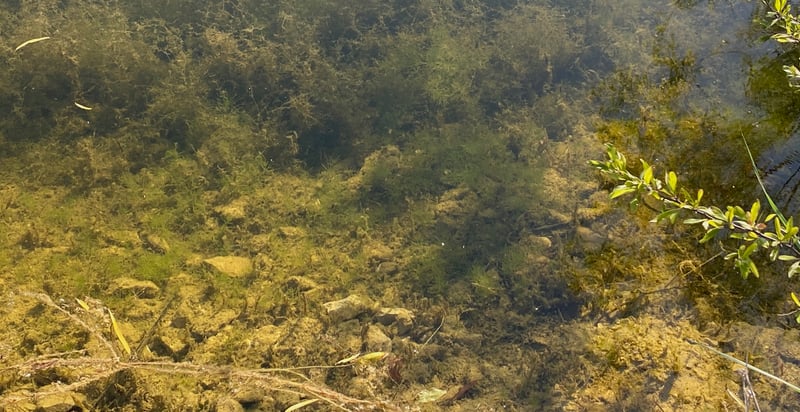
Managing Your Pond’s Water Clarity
Depending on the time of year and size of the fishery, water clarity is one of the easier aspects to manage if the current conditions don't match your goals. For example, suppose a pond or lake has too much clarity.
In that case, the predators, like Largemouth Bass, will have to expend more energy than necessary to capture prey because Bass aren't efficient open water predators.
Instead, they have adapted to become a highly efficient ambush predator. Fisheries that have increased clarity are easiest to adjust early in the year. Depending on the size of the pond, the application of either aquatic dye or fertilizer can help limit the amount of light transmission through the water. Adding aquatic fertilizer will help induce a phytoplankton bloom to achieve an ideal clarity range of 18"- 24": this will also help increase the productivity and growth potentials of all the fish species in your fishery.
The Size of Your Pond Matters if You Plan to Use Aquatic Fertilizer
An important reminder about aquatic fertilizer is that it should only be applied to ponds larger than 2 acres and only during the early in the growing season to help prevent nuisance vegetation from benefiting.
For ponds smaller than 2 acres, you can control water clarity with the application of aquatic dye. Applying dye helps reduce the clarity of the water and allows Bass to ambush prey more efficiently. It also reduces the risk of oxygen depletion in fisheries with reduced water volume.
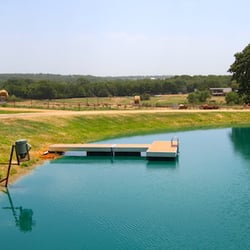
Dyed Pond |

Fertilized Pond |
Clear water also allows more sunlight to reach deeper portions of the pond or lake, increasing the areas where aquatic vegetation is able to grow. Small, managed portions of aquatic vegetation can help ensure a steady supply of juvenile forage species are recruited into the population, ensuring the sustainability of the population.
When ponds or lakes have a large portion that is taken over by aquatic vegetation, additional fish species whose diet consists primarily of aquatic vegetation are usually included in the stocking plan.
In larger fisheries with high turbidity levels, Bass can still reach quality sizes, but they aren't able to perform to the same degree as a fertilized pond. While yes, the baitfish can't see the predators coming, your Bass can't see your forage fish either.
This limited visibility makes the Bass rely heavily on their other senses to capture prey, “tying one hand behind their back”, making them work harder, limiting their growth potential.
What Type of Treatment is Good for Turbid Water?
A gypsum application is the recommended treatment of turbid waters in small fisheries; this helps bind suspended particles together and allows them to fall out of suspension. However, before applying gypsum, you should take steps to prevent the pond from becoming turbid again.
You can prevent your pond from becoming turbid again by:
- Ensuring that livestock has limited access to the fishery,
- Limiting the amount of exposed soil immediately near the pond,
- Planting beneficial aquatic vegetation to help slow the influx of runoff water that could stir up the pond bottom or introduce new sediments.
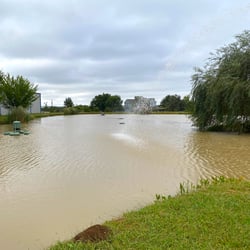
Before Gypsum |
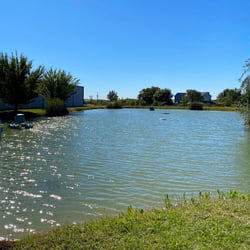
After Gypsum |
As stated earlier, we typically only recommend gypsum treatment for smaller fisheries. One of the primary reasons for only using it on smaller ponds is the amount needed to clear a pond is 1- to 2-tons per surface acre.
While the application of gypsum in bigger, highly turbid fisheries would produce the same results, the economics of the application often deters many customers.
Fish Stocking Plans for Ponds
The factors we discussed above allow you to determine which species are best suited to your pond or lake. Then, depending on the size of the pond, your budget and timeline will be the final factors in determining the sizes and quantities of the necessary species to achieve the ideal stock densities and proportions to get the most out of your fishery.
The benefit of utilizing correctly paired sizes of different fish species is that you don't have to wait to stock predatory species.
For owners of larger fisheries that don't mind waiting a couple of years to produce trophy Bass, stocking smaller fingerlings initially will help keep the cost more manageable.
This strategy allows you to stock the correct amount of predators and forage species all at once. For smaller fisheries or in cases where the timeline is limited, stocking of advanced fish will allow you to begin catching quality fish approximately within a couple of seasons.
Professionally Planned Fish Stocking Strategies
The fisheries biologies of Pond King have created several fish stocking packages for various pond conditions and customer preferences for stocking new ponds with the correct proportion of predators and forage species.
We have packages that range from species ideal to stock in chronically muddy ponds, create a miniature lake experience in your backyard, to Bass fisheries that are ready to fish next weekend.
All of these packages have ideal stocking densities for a 1-acre pond, making it easy to determine the correct amount and approximate costs for stocking your pond.
For example, if you have a 5-acre pond and want to stock it with Trophy Bass Mix 2, simply multiply the stocking quantities and package total by 5, and you'll have an idea of how many fish are included and the approximate cost.
Custom Fish Stocking Plans
Now, if you have a pre-existing fishery or just want to create a customized stocking plan, you can always call, email, or come visit with us at the shop, and we would be happy to design a fish stocking plan for you.
We have a steady supply of fish delivered to our facility during peak stocking seasons, March- June, and September- November. We hold a wide variety of species for stocking, and some of our popular fish species include Hybrid Striped Bass, Largemouth Bass (Native and F1 strain), Coppernose Bluegill, Redear Sunfish, and Channel Catfish. We typically carry various sizes of each species to fit your stocking plan perfectly.
Call Ahead for Information on Fish Stock Availability
If you decide to visit our shop to purchase some fish to stock your pond, be sure to give us a call first to schedule an appointment. You’ll want to verify that we will have all of your desired species and the correct quantities for your stocking plan, as well as get an idea about how much room you will need in your vehicle. Our fish inventory changes very quickly, and we’d hate for you to make an unnecessary trip!
Transporting Your Fish to Their New Home!
When you come by to pick up a smaller order of fish, you will come to our Fish Barn. Bring the kids too, as it’s fun to watch the fish get scooped up out of the tank and put into the oxygen-filled plastic bags. These bags are about the size of a five-gallon bucket and contain enough oxygen to keep your fish healthy for 2 to 2-1/2 hours. Once you arrive at your pond, it is essential to let these bags float in the water for 10-15 minutes to allow the fish to acclimate to the pond's water temperature. After acclimating, release a few fish from the bag. If they quickly swim off into the pond, you are ready to let the rest go.
Longer Distance Transport Options are Available
For larger orders or those outside this 3-hour timeframe, give us a call to discuss other options or to discuss a fish delivery. Our trained biologists deliver fish in specially designed vehicles and transport tanks to keep your fish in top condition from our facility to your pond. These tanks provide a continuous flow of oxygen so the fish can be transported safely up to 6 hours away.
Contact Pond King, Inc. with Questions about Pond Stocking
There are a variety of factors that go into choosing the correct species, sizes, and quantities of fish that should be stocked in your fishery. Hopefully, this information helps you be better informed and the decision-making process a little easier when it comes to improving or starting your fishery.
If you have any questions about your pond or the factors that go into stocking it, or if you would like to put together a custom stocking plan, feel free to contact our fisheries biologists or call our team for more information!
See y'all down at the pond!
Editor's Note: Originally published in April 2018, this blog was updated in December 2020, and again in February 2022 for freshness, accuracy, and comprehensiveness.


